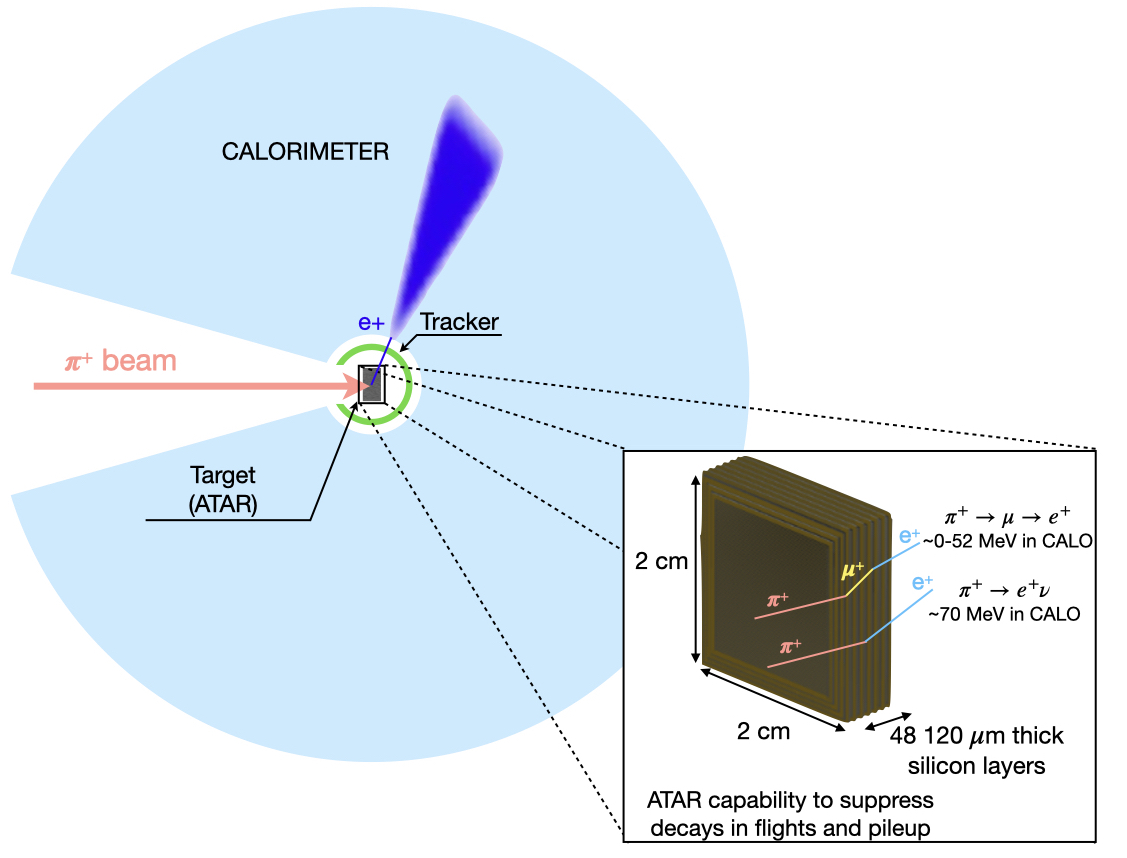The Physics
Lepton Flavor Universality
In its initial phase, PIONEER’s objective is to improve the measurement of the ratio between pions (\(\pi^+\)) decaying into positrons (\(e^+\)) and those decaying into muons (\(\mu^+\)):
\[R_{e/\mu}=\frac{\pi^+\rightarrow e^+ \nu_e (\gamma)}{\pi^+\rightarrow \mu^+ \nu_{\mu} (\gamma)}= 1.2327(23)\times 10^{-4}.\]PIONEER aims at improving the current measurement by more than an order of magnitude, aligning it with the precision level achieved by theory. At this precision, PIONEER will provide the best test of the hypothesis that the electron-type particles (e.g. electrons and muons known as leptons) have identical weak interaction strengths. This is a feature of the Standard Model of particle physics (SM) known as lepton flavour universality (LFU). Recent ‘anomalies’ observed at the Large Hadron Collider (LHC at CERN) and elsewhere hint at a potential violation of LFU, which would be a sign of new physics, strongly motivating new precision measurements.
Beyond Standard Model
PIONEER will also be sensitive to a wide range of new physics scenario including at very high energies. This will include searches for exotic rare decays such as those involving sterile neutrinos or dark particles.
The Technology
PIONEER will be using the world’s most intense pion beam at the Paul Scherrer Institute (PSI) in Switzerland, and state-of-the-art detectors.
Overview of the Experiment Design
The incoming pion beam will stop in an active target. Pions will decay to either a muon which itself decays to a positron, or directly to a positron. The positron will enter a calorimeter used to precisely measure its energy.

In essence the experiment consists in counting the number of times pion decay to a positron versus to a muon. Energy and timing information of the emitted positron allow an initial separation of the two decays but decays in flight and pileup complicate the accurate counting. Additionnaly low energy \(e^+\) events (low energy tail) from \(\pi^+\rightarrow e^+ \nu_e (\gamma)\) decay buried under the much more prominent Michel spectrum from muon decays have to be accurately accounted for. To this purpose PIONEER’s detector concept draws from, combines and augment the advantageous features of the previous two experiments (PEN and PIENU): PIONEER will use a dense, high light yield, high energy resolution, large solid angle and fast calorimeter as well as a highly segmented active target.
The Active Target (ATAR)
The ATAR is an active target with “5D” tracking (x, y, z, t, E) capabilities achieved with LGADs (low gain avalanche diode). This will be used to reduce pileup and get a much improved precision on the low energy tail correction.
The Calorimeter
We are investigating two options for a calorimeter with large acceptance and a 20-25 radiation length depth: a large homogeneous volume of liquid xenon (LXe) or segmented LYSO crystals.
Previous Experiments
PIONEER is building off of the experiences of previous-generation experiments: PIENU and PEN. PIENU took data at TRIUMF between 2009 and 2012, currently providing the most precise measurement of \(R_{e/\mu}\). It had a small forward-only acceptance and used a large 19 radiation lengths single crystal of NaI(Tl) surrounded by CsI crystals for shower-leakage containment. The PEN experiment, ran at PSI and used a sphere-like 3\(\pi\)-acceptance segmented calorimeter made of 12 radiation lenghts CsI crystals.
Phase II and III of PIONEER
In a later stage PIONEER aims at an improved measurement of the \(\pi^+\rightarrow \pi^0 e^+\nu\) branching ratio which will address current tensions in the quark flavor sector.